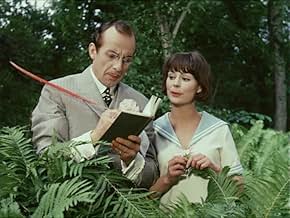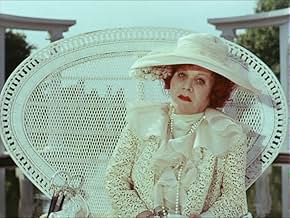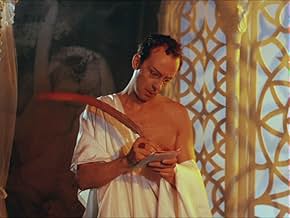NOTE IMDb
5,4/10
2,7 k
MA NOTE
Ajouter une intrigue dans votre langueA critic blackmails a famous musician with his biography filled with the revelations of many of his women.A critic blackmails a famous musician with his biography filled with the revelations of many of his women.A critic blackmails a famous musician with his biography filled with the revelations of many of his women.
- Réalisation
- Scénario
- Casting principal
- Récompenses
- 1 nomination au total
Jan Blomberg
- English Radio Reporter
- (non crédité)
Lars-Owe Carlberg
- Driver
- (non crédité)
Axel Düberg
- Man in Black
- (non crédité)
Doris Funcke
- Waitress
- (non crédité)
Göran Graffman
- French Radio Reporter
- (non crédité)
Yvonne Igell
- Waitress
- (non crédité)
Ulf Johansson
- Man in Black
- (non crédité)
Avis à la une
This comedy, most notable for being Bergman's first film in color, is often considered one of his worst. I went into it with very low expectations, glad that it was just 80 minutes long. Thankfully, it's not nearly as bad as its reputation. It's minor Bergman, for sure. It's main crime is that it thinks it's much funnier than it ever is. That can be annoying, but, really, the film isn't exactly unfunny. Personally, I think Bergman only did comedy right once, with Smiles of a Summer Night, and even that one I don't think is amongst his best work. Simply put, Bergman excels at tragedy, and his comedy can feel forced. This film revolves around an art critic (Jarl Kulle, Bergman's most mugging actor) who comes to write a biography of a famous cellist at his palatial estate. The cellist (whose face never appears on screen) is a philanderer, surrounding himself with women of various ages (including Bibi Andersson, Harriet Andersson and Eva Dahlbeck). Kulle starts a fling with Bibi Andersson, and soon discovers that one of the wives or mistresses is attempting to murder the cellist. The Bergman film this reminds me most of is The Devil's Eye, which also stars Kulle (if I recall correctly, that one is slightly less comic). The color cinematography is actually quite excellent. Bergman didn't film again in color until Cries and Whispers. This is available on Hulu Plus.
I do say this with a heavy heart as I love and admire Ingmar Bergman and many of his films and thought I'd never see a film of his I didn't like. Until now. By all means it has its good points, the cinematography, settings and music are beautiful and the female cast(with three of Sweden's finest ever actresses) look splendid and really try their best. Unfortunately, Jarl Kulle does nothing to make his annoying character remotely likable. Cornelius isn't the only bad character here though, I didn't care for any of them and none are interesting, for a Bergman film that is unusual. Bergman I love as a director, but he too seems out of his depth with a lack of momentum. The writing seems forced and unfunny, while the story tries to do much but does so in a clumsy and stilted manner.
Overall, I really wanted to love All These Women considering the talent involved, but I found it a really disappointing miscalculation.
4/10 Bethany Cox
Overall, I really wanted to love All These Women considering the talent involved, but I found it a really disappointing miscalculation.
4/10 Bethany Cox
Ingmar Bergman cuts loose with this atypical homage to bedroom farce and (sometimes silent) slapstick comedy, a lark for one of the most serious filmmakers around the globe. There are fun moments, especially when Bergman breaks the fouth wall and winks at the audience ("these fireworks are not meant to be symbolic"!), but overall the film is stilted, static, and rather tiresome. The women are dazzling, but mostly wasted; despite the title, the central character is a man, and he occupies something like 90% of the running time. ** out of 4.
I never thought that I would have to say that but I did not like the Ingmar Bergman's film "All These Women". In spite the very pretty and delicate pink and blue cinematography and the presence of the charming and talented actresses, the movie was a mess of an attempt to create a comedy. Everything that was subtle, sensual, and charming in B/W "Smiles of a Summer Night" (1955) was missing here. First of all - the Jarl Kulle's performance as a music critic - biographer, Cornelius. Kulle was very effective and funny in "Smiles...", in "Women..." - he plays an irritating, annoying, and the worst - absolutely not funny (which is a crime for a comedy) character. If in "Smiles... the writing was a first class and sparkled, I got the impression that in "Women.." Bergman did not care or did not want to work on the script and was more interested in experimenting with colors and music. The movie looks and sounds fine - it is Bergman, after all, but that's the only redeeming qualities that I found.
4/10
4/10
Comedy without laughs? Certainly. Anyone looking for clever retorts and hilarious situations will be frankly disappointed. Actually, comedy here is nothing more than a style adopted by Bergman for his usual speech. It is the tone that interests him, the tone of farce, of slapstick.
Also Bergman's taste for the theater, for the comedians who appear so many times in his films, for the professionals who repeat the learned and inherited routines, knowing that an actor who knows his job can always make them fun again.
And Bergman when it comes to comedians has the best, not only extraordinary actors but disciplined workers capable of adapting to what the director asks of them at all times. And they indulge in the tired comic routines with absolute conviction and immeasurable talent: above all Jarl Kulle as Cornelius, the critic who goes to visit the master in his summer villa to write the biography of the musician; and of course, the cast of great actresses: Gertrude Frigh (the great theater actress who would be her Hedda Gabler on stage, in addition to appearing in important roles in several of her most famous films), Bibi Andersson (one of the great actresses in Bergman's work), or the wonderful Eva Dahlbeck (even more beautiful than in Smiles) and Harriet Andersson.
The scenes are often amazingly choreographed, with a markedly theatrical nature, and one cannot help but think about the repetitions, the hours of rehearsals necessary for the gear to work with that perfection and that rapport between the actors and the director.
Visually it is a highly sophisticated work, with wonderful color photography by Sven Nykvist and spectacular production design by another regular from the director, P. A. Lundgren, who creates a kind of Hadrian's Villa spiced up with decorations between Rococo and Neo-Gothic, where each room is like a stage of marble and stucco barely occupied by the minimum props required by the scene and white Roman sculptures.
The work is funny, extremely agile, consciously ridiculous, the problem is that Bergman's speech is not as rich as in other works of his (as an advantage it must be said that he does not fall into the pedantry that ruins so many scenes of his work) and no real depth. It is an assumedly minor work, a harmless game about the relationships and mutual dependence of the critic and the artist, about the exposure of the artist in his work and the public's desire to investigate the life and mind of the artist, about the need that artists have for critics who explain them and by studying them places the artists in history. The critic is a vain, selfish, indiscreet, amoral being, but he is at the same time humiliated, used, deceived, ignored. The artist is a mysterious figure, distant, somewhat repulsive from the outside, and elusive, who speaks only through his art.
The direction, as always, is masterful. The work moves away from the gloomy and expressionist style of his previous films (the famous trilogy) and shows that Bergman was looking for new directions, new cinematographic resources. His next films are his two great masterpieces: Persona and The Hour of the Wolf.
Those Women is a far cry from Bergman's great works, but it is by no means the worst of his films. Taking it on its own terms, it's a risky step taken by a director who wanted to present his discourse in a totally new way, with a radically different aesthetic and approach than the one that had so much critical acclaim. The problem is that the movie doesn't tell us too much either. For some it may be the extreme case of the emptiness of content in the background of so many Bergman films, I personally agree that the ultimate value of the director is more often in his expressive abilities in the medium than in the content of his sometimes pedantic and anguished scripts.
Also Bergman's taste for the theater, for the comedians who appear so many times in his films, for the professionals who repeat the learned and inherited routines, knowing that an actor who knows his job can always make them fun again.
And Bergman when it comes to comedians has the best, not only extraordinary actors but disciplined workers capable of adapting to what the director asks of them at all times. And they indulge in the tired comic routines with absolute conviction and immeasurable talent: above all Jarl Kulle as Cornelius, the critic who goes to visit the master in his summer villa to write the biography of the musician; and of course, the cast of great actresses: Gertrude Frigh (the great theater actress who would be her Hedda Gabler on stage, in addition to appearing in important roles in several of her most famous films), Bibi Andersson (one of the great actresses in Bergman's work), or the wonderful Eva Dahlbeck (even more beautiful than in Smiles) and Harriet Andersson.
The scenes are often amazingly choreographed, with a markedly theatrical nature, and one cannot help but think about the repetitions, the hours of rehearsals necessary for the gear to work with that perfection and that rapport between the actors and the director.
Visually it is a highly sophisticated work, with wonderful color photography by Sven Nykvist and spectacular production design by another regular from the director, P. A. Lundgren, who creates a kind of Hadrian's Villa spiced up with decorations between Rococo and Neo-Gothic, where each room is like a stage of marble and stucco barely occupied by the minimum props required by the scene and white Roman sculptures.
The work is funny, extremely agile, consciously ridiculous, the problem is that Bergman's speech is not as rich as in other works of his (as an advantage it must be said that he does not fall into the pedantry that ruins so many scenes of his work) and no real depth. It is an assumedly minor work, a harmless game about the relationships and mutual dependence of the critic and the artist, about the exposure of the artist in his work and the public's desire to investigate the life and mind of the artist, about the need that artists have for critics who explain them and by studying them places the artists in history. The critic is a vain, selfish, indiscreet, amoral being, but he is at the same time humiliated, used, deceived, ignored. The artist is a mysterious figure, distant, somewhat repulsive from the outside, and elusive, who speaks only through his art.
The direction, as always, is masterful. The work moves away from the gloomy and expressionist style of his previous films (the famous trilogy) and shows that Bergman was looking for new directions, new cinematographic resources. His next films are his two great masterpieces: Persona and The Hour of the Wolf.
Those Women is a far cry from Bergman's great works, but it is by no means the worst of his films. Taking it on its own terms, it's a risky step taken by a director who wanted to present his discourse in a totally new way, with a radically different aesthetic and approach than the one that had so much critical acclaim. The problem is that the movie doesn't tell us too much either. For some it may be the extreme case of the emptiness of content in the background of so many Bergman films, I personally agree that the ultimate value of the director is more often in his expressive abilities in the medium than in the content of his sometimes pedantic and anguished scripts.
Le saviez-vous
- AnecdotesThis is Ingmar Bergman's first color film.
- Crédits fousThe disclaimer at the beginning states that: "Every similarity between this film and the so-called reality has to be a misunderstanding".
- Bandes originalesOrchestral Suite No. 3 D-dur (BWV 1068)
Composed by Johann Sebastian Bach
Meilleurs choix
Connectez-vous pour évaluer et suivre la liste de favoris afin de recevoir des recommandations personnalisées
- How long is All These Women?Alimenté par Alexa
Détails
- Durée1 heure 20 minutes
- Mixage
- Rapport de forme
- 1.37 : 1
Contribuer à cette page
Suggérer une modification ou ajouter du contenu manquant

Lacune principale
By what name was Toutes ses femmes (1964) officially released in India in English?
Répondre































